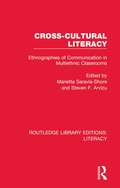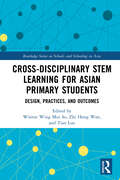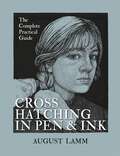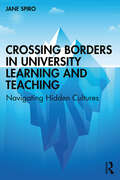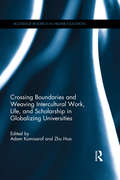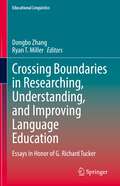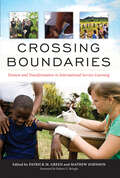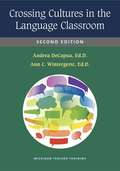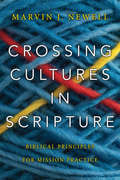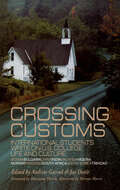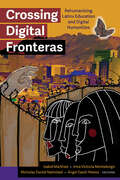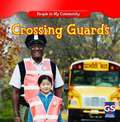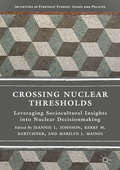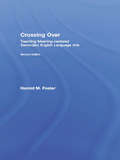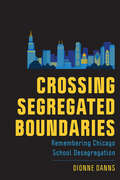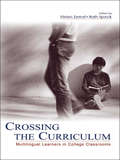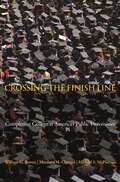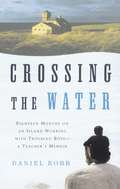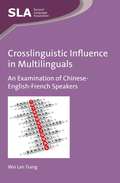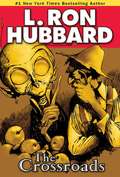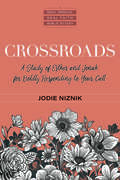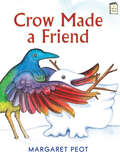- Table View
- List View
Cross-cultural Literacy: Ethnographies of Communication in Multiethnic Classrooms (Routledge Library Editions: Literacy #1)
by Marietta Saravia-Shore Steven F. ArvizuOriginally published in 1992. This book advocates and demonstrates the benefits of an anthropological approach that recognizes the centrality of culture in the educational process. This approach encompasses knowledge and understanding of other cultures’ patterns of interaction, values, institutions, metaphors and symbols as well as cross-cultural communication skills. Ethnographic studies of multi-ethnic classrooms and schools in their community context are presented in this excellent volume with a view to informing practice and policy concerning the education of language minority students and teachers, and anyone with an interest in foreign language education and bilingual education.
Cross-curricular Approaches to Teaching and Learning
by Hilary Cooper Mr Chris RowleyWhat would the primary curriculum look like with humanities at its heart? How can cross-curricular work help children to learn more effectively? With practical ideas on how to join up the primary curriculum, this book uses history and geography to explore different contexts and strategies for making links between the full range of primary subjects, so that learning can be more integrated and relevant to learners. The authors demonstrate how these subjects can serve as the basis upon which values can be developed in the curriculum. There are powerful case studies, including examples of pupils' work and talk, and teachers' reflections. Additional materials to accompany the book can be found at: www.sagepub.co.uk/rowleyandcooper Written by a group of practising teachers and university tutors, this book will be invaluable to primary teachers, student teachers and all those involved in curriculum design. Chris Rowley is Senior Lecturer in and Geographical and Environmental Education at the University of Cumbria, UK. Dr Hilary Cooper is Professor of History and Pedagogy at the University of Cumbria, UK.
Cross-disciplinary STEM Learning for Asian Primary Students: Design, Practices, and Outcomes (Routledge Series on Schools and Schooling in Asia)
by Tian Luo Zhi Hong Wan So, Winnie Wing MuiGiven the importance of student learning in the various types and integration of STEM education, this book provides a landscape of cross-disciplinary STEM learning in Asian primary schools, and a systematic overview of design, practices, and outcomes of STEM learning implementation. Science, Technology, Engineering and Mathematics (STEM) has continued to attract attention worldwide, and there have been calls for the promotion of STEM education in primary schools to nurture students to meet the needs of societies in terms of innovation and technology development. Since STEM is complex in nature and is related to various disciplines, the effort of a single discipline may not be as effective as cross-disciplinary efforts. This edited volume, involving an Asian team of authors, examines how cross-disciplinary STEM learning can be designed for students to achieve viable outcomes, and what opportunities and challenges have been offered to the next generation to equip them with the necessary skills, knowledge, and ways of thinking, as well as attitudes and values for lifelong learning. A resourceful text for students, researchers, and practitioners interested in the rich development of STEM education and practical methods for a variety of learning approaches from elementary to secondary education has been provided.
Cross-talk in Comp Theory: A Reader
by Kristin L. Arola Victor VillanuevaThe 3rd edition of this invaluable anthology features eight new essays, including six in the new technology section, "Virtual Talk: Composing Beyond the Word," edited by Victor Villanueva and Kristin L. Arola. <p><p>For the third edition of Cross-Talk in Comp Theory, Victor Villanueva recruited the expertise of colleague Kristin L. Arola in order to flesh out the discussion on composition and technology. The quick movement of the paradigm—from the personal computer to local-area networks to the rise of social networking—suggests the need to recall the talk and the cross-talk concerning computers and their products for composition. <p><p>The award-winning Villanueva and his coeditor Arola have dropped nine essays from the second edition, reoriented others into new sections, and added eight new essays, including six in the new technology section, "Virtual Talk: Composing Beyond the Word." Amid these changes, the third edition maintains the historical perspective of previous editions while continuing to provide insights on the relatively new discipline of composition studies. <p><p>Landmark contributions by major figures such as Donald Murray, Janet Emig, Walter Ong, Sondra Perl, Mike Rose, and Patricia Bizzell remain. They are joined by the works of other trailblazing scholars such as Peter Elbow and Richard Ohmann. This edition also incorporates texts by key names within comp's conversations on technology, including Adam Banks, Cynthia Selfe, and Kathleen Blake Yancey. <p><p>The result is a collection that continues to provide new and experienced teachers and scholars with indispensable insights into the challenges, controversies, and ever-shifting currents within our rich and ever-evolving field.
Crosshatching in Pen & Ink: The Complete Practical Guide
by August LammLearn the unique art of crosshatching and create stunning works of art with expert guidance from August Lamm. How to Crosshatch in Pen & Ink begins with a potted history of the artform, and elucidates exactly what crosshatching entails, and where it came from. After a helpful exploration of the materials and media that a crosshatcher may need, there then begins a practical guide to the very basics of crosshatching, approaching concepts such as how to look accurately, and how to depict light, shape, and shadow.Once readers have the essentials under their belt, there are more complicated subjects such as anatomy, portraiture and still lifes to tackle. For each topic, August uses a combination of fine art examples, illustrations and step-by-step tutorials to take the reader through the fascinating and accessible process of crosshatching, from perception to execution. This is the essential, comprehensive guide to this fascinating artform, and will appeal to complete beginners alongside long-time aficionados of the practice.
Crosshatching in Pen & Ink: The Complete Practical Guide
by August LammLearn the unique art of crosshatching and create stunning works of art with expert guidance from August Lamm. How to Crosshatch in Pen & Ink begins with a potted history of the artform, and elucidates exactly what crosshatching entails, and where it came from. After a helpful exploration of the materials and media that a crosshatcher may need, there then begins a practical guide to the very basics of crosshatching, approaching concepts such as how to look accurately, and how to depict light, shape, and shadow.Once readers have the essentials under their belt, there are more complicated subjects such as anatomy, portraiture and still lifes to tackle. For each topic, August uses a combination of fine art examples, illustrations and step-by-step tutorials to take the reader through the fascinating and accessible process of crosshatching, from perception to execution. This is the essential, comprehensive guide to this fascinating artform, and will appeal to complete beginners alongside long-time aficionados of the practice.
Crossing Borders in University Learning and Teaching: Navigating Hidden Cultures
by Jane SpiroUncovering aspects of university culture which are often hidden or misunderstood, this book brings together international perspectives, showing the matches and mismatches between experience and expectation, as both staff and student face new academic cultures. Drawing on the stories of students and members of staff in the higher education sector as starting points for analysis, this book considers aspects such as the dynamics and pragmatics of university settings, from tutorial to lecture; the assignment and multiple text types from reflective logs to essays; different interpretations of grades, grading and feedback. Topics are explored with examples from critical incidents and narratives in international contexts – both where staff or students cross cultures and borders, and where they are functioning within the university culture with which they are most familiar. Ideal both for those new to learning and teaching in higher education, and those seeking to refresh their practice, this must-read book uses case studies and narratives to illustrate key challenges academics and students face. With consideration given to learning across cultures, the narratives and topics lead to enquiries which the reader can ask and research for themselves to find helpful answers to explain their own university experiences.
Crossing Boundaries and Weaving Intercultural Work, Life, and Scholarship in Globalizing Universities (Routledge Research in Higher Education)
by Zhu Hua Adam KomisarofThis book generates a fresh, complex view of the process of globalization by examining how work, scholarship, and life inform each other among intercultural scholars as they navigate their interpersonal relationships and cross boundaries physically and metaphorically. Divided into three parts, the book examines: (1) the socio-psychological process of crossing boundaries constructed around nations and work organizations; (2) the negotiation of multiple aspects of identities; and (3) the role of language in intercultural encounters, in particular, adjustment taking place at linguistic and interactional levels. The authors reflect upon and give meaning and structure to their own intercultural experiences through theoretical frameworks and concepts—many of which they themselves have proposed and developed in their own research. They also provide invaluable advice for transnational scholars and those who aspire to work and live abroad to improve organizational participation and mutual intercultural engagement when working in a globalizing workplace. Researchers and practitioners of applied linguistics, communication studies, and higher education in many regions of the world will find this book an insightful resource.
Crossing Boundaries in Researching, Understanding, and Improving Language Education: Essays in Honor of G. Richard Tucker (Educational Linguistics #58)
by Dongbo Zhang Ryan T. MillerThis volume brings together original papers from language education scholars from around the world to explore, exemplify, and discuss the multiplicity of boundary crossing in language education. It emphasizes the potential of boundary crossing for expansive learning, and aims to generate new insights, through boundary crossing, into the complexity of language education and approaches to innovative practices. This volume also underscores the important role of expert boundary crossers. In particular, it aims to honor G. Richard Tucker, Paul Mellon University Professor Emeritus of Applied Linguistics at Carnegie Mellon University, celebrating his distinguished scholarship on language education and paying tribute to the inspiration and mentorship he has given to the contributors of this volume to cross boundaries academically and professionally. This volume is organized into four sections, namely, language learning and development; teachers and instructional processes; program innovation, implementation, and evaluation; and language-in-education policy and planning. These sections or themes, which are necessarily cross-cutting, also represent the major areas of scholarship where Prof. Tucker has made distinguished contributions for over half a century.
Crossing Boundaries: Tension and Transformation in International Service-Learning
by Patrick M. Green, Mathew Johnson, Robert G. BringleAre there better ways to address community challenges than expending funds on international service-learning?In attempting to wed learning and service, are we are exploiting the “other” for new, or recycled, aims?As these questions attest, of all types of service-learning, international service-learning (ISL) most starkly illuminates the tensions between the liberatory and oppressive potentials of practice.This book explores the ramifications of realizing a new age of service-learning that pushes beyond single episodic course-based projects to rebalance student learning and community outcome priorities, and provides insight into what it looks like in its execution. In describing eleven international programs designed to achieve reciprocal, sustained relationships in which learning is co-created, the contributors reveal their struggles to change the balance of power relationships and move to a more transformative practice. Common themes are the developmental nature of this work; the recognition that it takes multiple attempts, often over years, for an individual or an institution to get this work even nearly right; that resolving the challenges of unequal resources, power, and privilege can never be completely erased; and that attention has to be given to the micro-level details.What emerge are seven guiding principles that define the nature of partnerships in liberatory practice, and that apply to all forms of service learning. They must be: strategic--linked to the mission and expertise of the institution; long-term; multifaceted--allowing both partners to play a multiplicity of roles; developmental in building capacities; contextualized in historic and cultural understanding; fully reciprocal; and create the potential for community-driven change.In addressing the problematic nature of ISL, and of service-learning in general, this book interrogates whether its experiences create the necessary conditions for the formation of individual values, convictions, and action; and whether their pivotal teaching and learning moments are indeed replicable and transferable across individual, institutional and even cultural contexts. Its conclusions and insights will be of intense interest to administrators and practitioners alike.
Crossing Cultures In The Language Classroom, Second Edition
by Andrea DeCapua Ann WintergerstCrossing Cultures in the Language Classroom attempts to balance theory and practice for pre-service and in-service teachers in general education programs or in ESL/EFL, bilingual, and foreign language teacher training programs, as well as cross-cultural awareness workshops. This book is unique in that it combines theory with a wide range of experiential activities and projects designed to actively engage users in the process of understanding different aspects of cross-cultural awareness. The goals of the book are to help readers: expand cultural awareness of one’s own culture and that of others achieve a deeper understanding of what culture is and the relationship between culture and language acquire the ability to observe behaviors in order to draw conclusions based on observation rather than preconceptions understand and implement observations of cultural similarities and differences develop an attitude of tolerance toward cultural differences and move away from the “single story.” The new edition has been thoroughly updated and includes a Suggested Projects section in each chapter. This section provides opportunities for users of the text to explore in greater depth an area and topic of interest. It also includes even more Critical Incidents--brief descriptions of events that depict some element or elements of cultural differences, miscommunication, or culture clash. Critical Incidents develop users’ ability to analyze and understand how multiple perspectives of the same situation are rooted in differing culturally influenced beliefs, behaviors, norms of interaction, and worldviews.
Crossing Cultures in Scripture: Biblical Principles for Mission Practice
by Marvin J. Newell14th Annual Outreach Magazine Resource of the Year, Cross-Cultural Category
Crossing Customs: International Students Write on U.S. College Life and Culture (RoutledgeFalmer Studies in Higher Education #Vol. 18)
by Andrew Garrod Jay DavisFirst Published in 1999. Routledge is an imprint of Taylor & Francis, an informa company.
Crossing Digital Fronteras: Rehumanizing Latinx Education and Digital Humanities
by Isabel Martinez Irma Victoria Montelongo Nicholas Daniel Natividad Ángel David NievesCrossing Digital Fronteras is about liberatory possibilities and digital technologies in the classroom. The book centers critical Latinx Digital Humanities to illustrate the ways college faculty and Latinx students harness digital tools to engage in "messy" yet essential active learning and knowledge production in Hispanic-Serving Institutions (HSIs) and Latinx Studies courses. With increasing Latinx student enrollment and a growing need for the humanities in our complex world, it is essential that HSIs and instructors integrate twenty-first-century tools into their teaching practices to truly "serve" Latinx students and communities. This book definitively inserts Latinx Digital Humanities into broader conversations about best practices at HSIs, on the one hand, and digital humanities and social justice, on the other. Most importantly, it provides practical examples of innovative, rehumanizing digital pedagogies that give students the liberatory learning they deserve.
Crossing Guards (People in My Community)
by JoAnn Early MackenCrossing guards have a very important job—keeping us safe. In this book, beginning readers learn about the duties of a crossing guard, and see firsthand how these important community workers help to keep them safe every day on their way to school. Also covered are important safety rules about crossing the street.
Crossing Nuclear Thresholds: Leveraging Sociocultural Insights Into Nuclear Decisionmaking (Initiatives In Strategic Studies: Issues And Policies Ser.)
by Kerry M. Kartchner Jeannie L. Johnson Marilyn J. MainesThis book applies the cutting-edge socio-cultural model Cultural Topography Analytic Framework (CTAF) pioneered in the authors’ earlier volume Strategic Culture and Weapons of Mass Destruction: Culturally Based Insights into Comparative National Security Policymaking (Palgrave Macmillan, 2009) with an eye towards isolating those vectors of nuclear decision-making on which the US might exert influence within a foreign state. The case studies included in this volume tackle a number of the nuclear challenges—termed “nuclear thresholds”—likely to be faced by the US and identify the most promising points of leverage available to American policymakers in ameliorating a wide range of over-the-horizon nuclear challenges. Because near and medium-term nuclear thresholds are likely to involve both allies and adversaries simultaneously, meaning that US response will require strategies tailored to both the perception of threat experienced by the actors in question, the value the actors place on their relationship with the US, and the domestic context driving decision-making. This volume offers a nuanced look at each actor’s identity, national norms, values, and perceptual lens in order to offer culturally-focused insights into behavior and intentions.
Crossing Over: Teaching Meaning-centered Secondary English Language Arts
by Harold M. FosterThis text for secondary preservice and in-service English language arts teachers offers a rationale for meaning-centered English language arts teaching and practical strategies for application. Its goal is to provide readers with an understanding of the issues involved in English teaching and specific examples of how to apply this understanding to classrooms. Teaching strategies are presented through a series of stories depicting teachers from a variety of settings practicing their craft with secondary students. Features: *A solid introduction and interesting personal narratives introduce the issues and ideas involved in English language arts teaching. *Case studies based on actual teachers and students realistically illustrate methods that can be used in secondary English classes. *Lessons are described in sufficient detail to be converted to teaching models. *Multicultural emphasis prepares teachers for the contemporary classroom. *Chapters and sections incorporate the new literacies of TV, film, and computers in the English language arts class. *Pedagogical aids include end-of-chapter questions and activities, reproducible charts and worksheets; an updated listing of young adult novels; and annotated recommended readings. *An appendix on writing a personal narrative helps students develop as writers. New in the Second Edition: *Updates. All chapters, the bibliographies, and the references are thoroughly updated to reflect changes since the first edition was published. Chapters 1 and 2 have been totally rewritten. *Standards/Benchmarks. The IRA/NCTE Standards for the English Language Arts are incorporated into the text. Benchmarks and Performance Assessment Measures are included in all the pedagogical chapters to address proficiency concerns. A section on helping students prepare for state proficiency tests has been added. *Computers. More is included on the use of technology, both as a content to learn and as a process for learning. *New Sample Unit Plans. Sections based on the instructional stories offer examples to help readers prepare for teaching. *Literature response questions. These are now provided in Chapter 4 for use in journaling and discussions. *Glossary. A chapter on important terms and useful strategies for the English language arts classroom has been added.
Crossing Segregated Boundaries: Remembering Chicago School Desegregation (New Directions in the History of Education)
by Dionne DannsScholars have long explored school desegregation through various lenses, examining policy, the role of the courts and federal government, resistance and backlash, and the fight to preserve Black schools. However, few studies have examined the group experiences of students within desegregated schools. Crossing Segregated Boundaries centers the experiences of over sixty graduates of the class of 1988 in three desegregated Chicago high schools. Chicago’s housing segregation and declining white enrollments severely curtailed the city’s school desegregation plan, and as a result desegregation options were academically stratified, providing limited opportunities for a chosen few while leaving the majority of students in segregated, underperforming schools. Nevertheless, desegregation did provide a transformative opportunity for those students involved. While desegregation was the external impetus that brought students together, the students themselves made integration possible, and many students found that the few years that they spent in these schools had a profound impact on broadening their understanding of different racial and ethnic groups. In very real ways, desegregated schools reduced racial isolation for those who took part.
Crossing the Curriculum: Multilingual Learners in College Classrooms
by Ruth Spack Vivian ZamelAs college classrooms have become more linguistically diverse, the work of ESOL professionals has expanded to include research on the experiences of multilingual learners not only in ESOL courses but also in courses across the curriculum. At the same time that ESOL professionals are trying to understand the academic challenges that learners face beyond ESOL courses, faculty across the disciplines are trying to meet the challenge of teaching students of differing linguistic backgrounds. Crossing the Curriculum: Multilingual Learners in College Classrooms responds to these issues and concerns by capturing the complex and content-specific nature of students' and teachers' experiences and providing a nuanced understanding of how multilingual students' learning can be fostered and sustained. Crossing the Curriculum: Multilingual Learners in College Classrooms is unique in bringing together the perspectives of researchers, students, and teachers. These multiple lenses allow for a richly layered picture of how students and teachers actually experience college classrooms. Common themes and pedagogical principles resonate across the three distinct sections of the book:*Part One, "Investigating Students' Experiences Across the Curriculum: Through the Eyes of Classroom Researchers," consists of chapters written by ESOL and composition researchers who have investigated multilingual students' experiences in undergraduate courses across the curriculum.*Part Two, "Learning Across the Curriculum: Through Students' Eyes," consists of chapters written by two multilingual learners who chronicled their experiences as they crossed the curriculum over time.*Part Three, "Engaging Students in Learning: Through the Eyes of Faculty Across the Curriculum," consists of chapters written by faculty from several academic fields--Anthropology, Philosophy, Nursing, Literature, Sociology, and Asian American Studies--who discuss their own attempts to address the needs of multilingual learners in their classrooms.
Crossing the Finish Line: Completing College at America's Public Universities (The William G. Bowen Series #59)
by William G. Bowen Matthew M. Chingos Michael McPhersonWhy so many of America's public university students are not graduating—and what to do about itThe United States has long been a model for accessible, affordable education, as exemplified by the country's public universities. And yet less than 60 percent of the students entering American universities today are graduating. Why is this happening, and what can be done? Crossing the Finish Line provides the most detailed exploration ever of college completion at America's public universities. This groundbreaking book sheds light on such serious issues as dropout rates linked to race, gender, and socioeconomic status.Probing graduation rates at twenty-one flagship public universities and four statewide systems of public higher education, the authors focus on the progress of students in the entering class of 1999—from entry to graduation, transfer, or withdrawal. They examine the effects of parental education, family income, race and gender, high school grades, test scores, financial aid, and characteristics of universities attended (especially their selectivity). The conclusions are compelling: minority students and students from poor families have markedly lower graduation rates—and take longer to earn degrees—even when other variables are taken into account. Noting the strong performance of transfer students and the effects of financial constraints on student retention, the authors call for improved transfer and financial aid policies, and suggest ways of improving the sorting processes that match students to institutions.An outstanding combination of evidence and analysis, Crossing the Finish Line should be read by everyone who cares about the nation's higher education system.
Crossing the Water: Eighteen Months on an Island Working with Troubled Boys -- A Teacher's Memoir
by Daniel RobbOff the coast of Cape Cod lies a small windswept island called Penikese. Alone on the island is a school for juvenile delinquents, the Penikese Island School, where Daniel Robb lived and worked for three years as a teacher. By turns harsh, desolate, and starkly beautiful, the island offers its temporary residents respite from lives filled with abuse, violence, and chaos. But as Robb discovers, peace, solitude, and a structured lifestyle can go only so far toward healing the anger and hurt he finds not only in his students but within himself. Lyrical and heartfelt, Crossing the Water is the memoir of his first eighteen months on Penikese, and a poignant meditation on the many ways that young men can become lost.
Crosslinguistic Influence in Multilinguals: An Examination of Chinese-English-French Speakers
by Wai Lan TsangThis book reports on a research project conducted in multilingual Hong Kong, where Cantonese is the mother tongue (L1) of the majority of the population and learning different foreign languages is commonplace. In addition to English, which is usually the second language (L2), more and more people learn other languages, such as French (L3). Drawing on the notions of 'interface' and 'reverse transfer' in second language acquisition, this book addresses the possible role of L3 French in the acquisition of English as an L2 with two major concerns: firstly, the degree to which L3 acquisition will bring about a positive or negative transfer effect on L2 acquisition and secondly, the way in which an L3 interacts with an L2 and/or even an L1 on different interfaces as identified in second language acquisition. The study will appeal to researchers interested in second and third language acquisition, bi- and multilingualism and crosslinguistic influence.
Crossroads, The
by L. Ron HubbardExplore new worlds. Frustrated with a government that pays him to bury surplus produce in order to "fix" the economy while city folk starve, farmer Eben Smith decides to take matters into his own hands. He piles up his wagon with ripe fruits and vegetables and sets out for the first time to barter his goods in the big city.Being Eben's first city trip and all, the way soon becomes uncertain. But when Eben comes across a strange crossroads, he discovers that he's fallen into a nexus in time. Soon he's bartering a lot more than goods with different cultures in alternative realities . . . accidentally wreaking havoc and chaos in each. ALSO INCLUDES THE FANTASY STORIES "BORROWED GLORY" AND "THE DEVIL'S RESCUE" "Once again another collection of larger than life stories to lose yourself for a couple of hours." --Gil T's Pleasure Blog* An International Book Awards Finalists
Crossroads: A Study of Esther and Jonah for Boldly Responding to Your Call (Real People, Real Faith Bible Study)
by Jodie NiznikDiscover how to live out your unique calling from an unlikely biblical pairingAt first glance, Esther and Jonah don't have much in common. Esther is an orphan girl, out of place in royal courts, who nonetheless becomes queen and saves her beloved Jewish people. Jonah is a reluctant prophet who ran as hard as he could from God. And when he finally gave in and his efforts eventually saved his enemies, he did nothing but complain.While Esther and Jonah endured wildly different circumstances and had distinctly singular callings, they were both appointed by God. They were placed in a certain time and space in history. God carried them through unique experiences and gave them specific gifts. Despite their opposite attitudes of willingness, their lives are proof of the great things we can accomplish when we follow God's call.In this nine-week inductive Bible study, Jodie Niznik invites you to learn that you too are uniquely equipped and called by God for a particular assignment in a specific time and place. Now you stand at a crossroads, and the choice is yours. Will you choose to boldly respond like Esther or will you fight your calling like Jonah? With thoughtful questions and practical exercises, Niznik will gently help you examine your life through the lens of Scripture and take brave, bold steps forward into the life you long for!
Crow Made a Friend (I Like to Read)
by Margaret PeotTry, try again is the lesson Crow teaches beginning readers in this picture book reader. Crow was all alone. But like all crows, he was very clever. Using autumn leaves for wings, sticks for the body and a crab apple for the head, Crow made a friend! But winter winds blew in, destroying his creation. Undaunted, Crow fashioned another bird friend out of snow but could not prevent it from melting in the warm spring sun. Alone again, Crow heard the caw, caw, caw of a real, live bird. Together they built a nest and by summer, Crow had a family. This warm, satisfying story celebrates perseverance and ingenuity. An I Like to Read® book. Guided Reading Level D.
